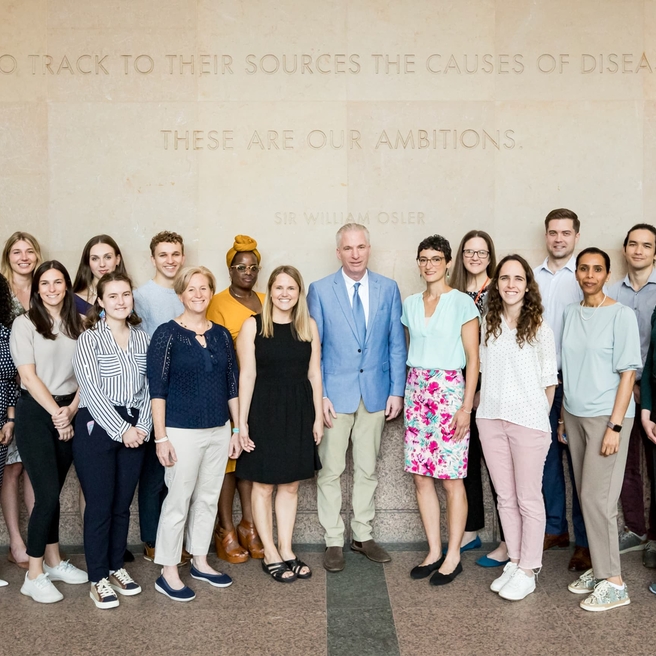What is mitochondrial diabetes?
Mitochondrial disorders impair the function of mitochondria, the tiny compartments in every cell of the body that produce the energy needed by cells. Depending on which cells have fewer or lower-functioning mitochondria, different symptoms may occur. Organs and body parts that require more energy, such as the heart, muscles and brain, are often affected. Mitochondrial disease is the name for a large number of mitochondrial disorders, with different genetic causes and presentations.
The body’s production of insulin depends on mitochondrial activity. If a mitochondrial disorder affects the cells in the pancreas that produce insulin, diabetes can be a feature of the patient’s mitochondrial disorder. Mitochondrial disorders may also cause insulin resistance in multiple body tissues, which increases the amount of insulin needed to control the absorption of glucose from the blood into fat, liver and muscle cells. For example, children with Friedreich’s ataxia, one form of mitochondrial disease, often have insulin deficiency and an increased chance of diabetes. As they grow older, adolescents and adults with Friedreich’s ataxia also develop insulin resistance, and their chance of developing diabetes increases further. Diabetes also occurs commonly in other forms of mitochondrial disease, in particular Kearns-Sayre syndrome and MELAS syndrome.
Causes
Mitochondria are unique in that they have their own DNA called mitochondrial DNA, or mtDNA. Mutations in this mtDNA or mutations in nuclear DNA (DNA found in the nucleus of a cell) can cause mitochondrial disorders. Environmental toxins can also trigger mitochondrial disease.
Mitochondrial disorders can be inherited from one or both parents. Syndromes caused by mutations or deletions in mitochondrial DNA are often inherited from the mother. In some cases, the disorder is caused by a spontaneous (de novo) gene mutation and is not inherited.
Mitochondrial diabetes is caused by poor functioning of insulin-producing cells in the pancreas and/or by the emergence of insulin resistance as part of a mitochondrial disorder.
Signs and symptoms
Symptoms of mitochondrial diabetes are similar to those for type 1 and type 2 diabetes. These may include:
- Increased and significant thirst
- Increased urination
- Increased appetite, but weight loss instead of gain
- Dehydration
- Blurred vision
- Nausea and vomiting
- Irritability and mood changes
Children with mitochondrial diabetes may experience variations in blood sugar levels in different patterns than are typical with type 1 or type 2 diabetes. For example, some children with mitochondrial disease may develop high blood sugar levels and require insulin when they are ill or stressed, but not at other times. Some of these same children are also at risk for developing low blood sugar levels.
Testing and diagnosis
Mitochondrial disease is diagnosed with genetic testing. Diabetes can sometimes be the presenting symptom that leads to the genetic diagnosis of mitochondrial disorder. In other cases, diabetes may develop after the genetic diagnosis has already been made.
Diagnosis of diabetes is made on the basis of symptoms, in combination with blood and urine tests to look for the acute and chronic effects of abnormal blood sugar levels.
Treatment
The goal of treatment is to keep blood sugar levels within a safe range. Treatment of a child’s diabetes that occurs due to a mitochondrial disorder must be done in close collaboration with the different specialists who are treating the child. Some of the approaches to treat diabetes may be particularly helpful (or harmful) for other aspects of the condition, and medications or therapies that are used to treat other aspects of a child’s mitochondrial disease may affect the course or management of their diabetes.
Understanding the dynamics of diabetes when it occurs in the context of mitochondrial disorders is also critical for devising effective treatment. It is important to individualize the approach to diabetes in the context of each child’s genetic diagnosis.
Follow-up care
People with mitochondrial diabetes, children and adults, need regular monitoring to adjust treatment to their changing needs. This includes consultation with and testing by experts in mitochondrial disease as well as regular diabetes checkups and screenings.
Why choose CHOP?
Physicians in CHOP’s Monogenic and Atypical Diabetes Program have expertise in the diagnosis and treatment of rare forms of diabetes such as mitochondrial diabetes. We perform evaluations to properly identify patients with atypical diabetes, and to diagnose the specific forms of the conditions. We then establish individualized treatment programs for these patients, and work closely with families and the other specialists to manage those treatment plans.
The Monogenic and Atypical Diabetes Program works closely with CHOP’s Mitochondrial Medicine, a Frontier Program, and with the Friedreich’s Ataxia Program and the Congenital Hyperinsulinism Center.
Resources to help
Mitochondrial Medicine Program Resources
Caring for a sick child can be overwhelming. We have created resources to help you find answers to your questions and feel confident in the care you are providing your child.
